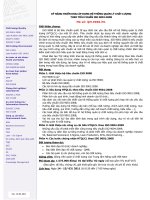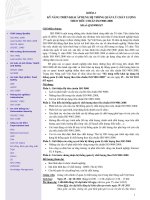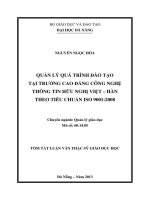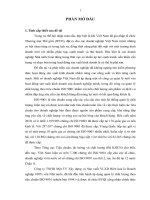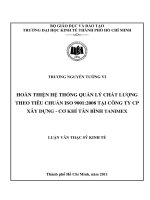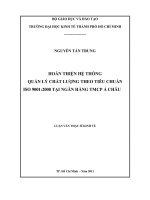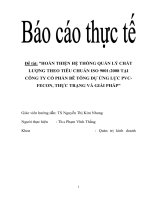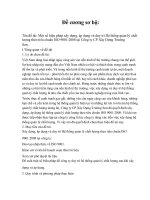Tiêu chuẩn iso 02597 2 2008
Bạn đang xem bản rút gọn của tài liệu. Xem và tải ngay bản đầy đủ của tài liệu tại đây (157.16 KB, 20 trang )
INTERNATIONAL
STANDARD
ISO
2597-2
First edition
2008-11-15
Iron ores — Determination of total iron
content —
Part 2:
Titrimetric methods after titanium(III)
chloride reduction
Minerais de fer — Dosage du fer total —
Partie 2: Méthodes titrimétriques après réduction au chlorure de
titane(III)
Reference number
ISO 2597-2:2008(E)
© ISO 2008
ISO 2597-2:2008(E)
PDF disclaimer
This PDF file may contain embedded typefaces. In accordance with Adobe's licensing policy, this file may be printed or viewed but
shall not be edited unless the typefaces which are embedded are licensed to and installed on the computer performing the editing. In
downloading this file, parties accept therein the responsibility of not infringing Adobe's licensing policy. The ISO Central Secretariat
accepts no liability in this area.
Adobe is a trademark of Adobe Systems Incorporated.
Details of the software products used to create this PDF file can be found in the General Info relative to the file; the PDF-creation
parameters were optimized for printing. Every care has been taken to ensure that the file is suitable for use by ISO member bodies. In
the unlikely event that a problem relating to it is found, please inform the Central Secretariat at the address given below.
COPYRIGHT PROTECTED DOCUMENT
© ISO 2008
All rights reserved. Unless otherwise specified, no part of this publication may be reproduced or utilized in any form or by any means,
electronic or mechanical, including photocopying and microfilm, without permission in writing from either ISO at the address below or
ISO's member body in the country of the requester.
ISO copyright office
Case postale 56 • CH-1211 Geneva 20
Tel. + 41 22 749 01 11
Fax + 41 22 749 09 47
Web www.iso.org
Published in Switzerland
ii
© ISO 2008 – All rights reserved
ISO 2597-2:2008(E)
Contents
Page
Foreword............................................................................................................................................................ iv
1
Scope ..................................................................................................................................................... 1
2
Normative references ........................................................................................................................... 1
3
3.1
3.2
Principle ................................................................................................................................................. 2
Decomposition of the test portion ...................................................................................................... 2
Titration of iron ..................................................................................................................................... 2
4
Reagents ................................................................................................................................................ 2
5
Apparatus .............................................................................................................................................. 4
6
6.1
6.2
Sampling and samples ......................................................................................................................... 5
Laboratory sample................................................................................................................................ 5
Preparation of test samples................................................................................................................. 5
7
7.1
7.2
7.3
7.4
7.5
Procedure .............................................................................................................................................. 5
Number of determinations ................................................................................................................... 5
Blank test and check test..................................................................................................................... 5
Determination of hygroscopic moisture content .............................................................................. 6
Test portion ........................................................................................................................................... 6
Determination........................................................................................................................................ 6
8
8.1
8.2
8.3
Expression of results ........................................................................................................................... 9
Calculation of total iron content.......................................................................................................... 9
General treatment of results................................................................................................................ 9
Oxide factors ....................................................................................................................................... 11
9
Test report ........................................................................................................................................... 11
Annex A (normative) Flowsheet of the procedure for the acceptance of analytical values for test
samples................................................................................................................................................ 12
Annex B (informative) Derivation of precision statements .......................................................................... 13
Annex C (normative) Procedure of the Japanese weighing method .......................................................... 14
Bibliography ..................................................................................................................................................... 15
© ISO 2008 – All rights reserved
iii
ISO 2597-2:2008(E)
Foreword
ISO (the International Organization for Standardization) is a worldwide federation of national standards bodies
(ISO member bodies). The work of preparing International Standards is normally carried out through ISO
technical committees. Each member body interested in a subject for which a technical committee has been
established has the right to be represented on that committee. International organizations, governmental and
non-governmental, in liaison with ISO, also take part in the work. ISO collaborates closely with the
International Electrotechnical Commission (IEC) on all matters of electrotechnical standardization.
International Standards are drafted in accordance with the rules given in the ISO/IEC Directives, Part 2.
The main task of technical committees is to prepare International Standards. Draft International Standards
adopted by the technical committees are circulated to the member bodies for voting. Publication as an
International Standard requires approval by at least 75 % of the member bodies casting a vote.
Attention is drawn to the possibility that some of the elements of this document may be the subject of patent
rights. ISO shall not be held responsible for identifying any or all such patent rights.
ISO 2597-2 was prepared by Technical Committee ISO/TC 102, Iron ore and direct reduced iron,
Subcommittee SC 2, Chemical analysis.
ISO 2597 consists of the following parts, under the general title Iron ores — Determination of total iron
content:
⎯
Part 1: Titrimetric method after tin(II) chloride reduction
⎯
Part 2: Titrimetric methods after titanium(III) chloride reduction
iv
© ISO 2008 – All rights reserved
INTERNATIONAL STANDARD
ISO 2597-2:2008(E)
Iron ores — Determination of total iron content —
Part 2:
Titrimetric methods after titanium(III) chloride reduction
1
Scope
This part of ISO 2597 specifies two titrimetric methods, free from mercury pollution, for the determination of
total iron content in iron ores, using potassium dichromate as titrant after reduction of the iron(III) by tin(II)
chloride and titanium(III) chloride. The excess reductant is then oxidized by either dilute potassium dichromate
(method 1) or perchloric acid (method 2).
Both methods are applicable to a concentration range of 30 % mass fraction to 72 % mass fraction of iron in
natural iron ores, iron ore concentrates and agglomerates, including sinter products.
WARNING — This part of ISO 2597 may involve hazardous materials, operations and equipment. This
part of ISO 2597 does not purport to address all of the safety problems associated with its use. It is the
responsibility of the user of this part of ISO 2597 to establish appropriate health and safety practices
and determine the applicability of regulatory limitations prior to use.
2
Normative references
The following referenced documents are indispensable for the application of this document. For dated
references, only the edition cited applies. For undated references, the latest edition of the referenced
document (including any amendments) applies.
ISO 31-0:1992, Quantities and units — Part 0: General principles
ISO Guide 35, Reference materials — General and statistical principles for certification
ISO 385, Laboratory glassware — Burettes
ISO 648, Laboratory glassware — Single-volume pipettes
ISO 1042, Laboratory glassware — One-mark volumetric flasks
ISO 2596, Iron ores — Determination of hygroscopic moisture in analytical samples — Gravimetric, Karl
Fischer and mass-loss methods
ISO 3082, Iron ores — Sampling and sample preparation procedures
© ISO 2008 – All rights reserved
1
ISO 2597-2:2008(E)
3
Principle
3.1
Decomposition of the test portion
3.1.1
Acid decomposition
For samples containing not more than 0,05 % mass fraction of vanadium, the test portion is treated with
hydrochloric acid in the presence of tin chloride and the residue is filtered, ignited and treated with hydrofluoric
and sulfuric acids. The mixture is fused with potassium disulfate and the cold melt is dissolved in water and
hydrochloric acid then neutralized with ammonia solution. The precipitate is filtered, washed in water,
dissolved in hydrochloric acid and combined with the main iron solution, which is treated with potassium
permanganate and evaporated.
3.1.2
Fusion-filtration
For samples containing more than 0,05 % mass fraction of vanadium, the test portion is fused with a mixture
of fluxes, the cold melt is leached with water and the precipitate is filtered, washed in sodium hydroxide
solution, dissolved in hydrochloric acid and evaporated.
3.2
Titration of iron
The major portion of the iron(III) is reduced by tin(II) chloride and the remainder of the iron(III) is reduced by
titanium(III) chloride. The excess reductant is oxidized with either dilute potassium dichromate solution
(method 1) or dilute perchloric acid (method 2). The reduced iron is titrated with potassium dichromate
solution using the sodium diphenylaminesulfonate indicator.
4
Reagents
During the analysis, use only reagents of recognized analytical reagent grade, and only distilled water or water
of equivalent purity.
Method
4.1
Hydrochloric acid, ρ 1,16 g/ml to 1,19 g/ml.
1 and 2
4.2
Hydrochloric acid, ρ 1,16 g/ml to 1,19 g/ml, diluted 1 + 1.
1 and 2
4.3
Hydrochloric acid, ρ 1,16 g/ml to 1,19 g/ml, diluted 1 + 12.
1 and 2
4.4
Hydrochloric acid, ρ 1,16 g/ml to 1,19 g/ml, diluted 2 + 100.
1 and 2
4.5 Hydrofluoric acid, 40 % mass fraction (ρ 1,13 g/ml) or 48 % mass fraction
(ρ 1,19 g/ml).
4.6
Sulfuric acid, ρ 1,84 g/ml.
1 and 2
4.7 Sulfuric acid, ρ 1,84 g/ml, diluted 1 + 1, carefully pour 1 volume of reagent 4.6 into
1 volume of cold water.
4.8
Orthophosphoric acid, ρ 1,7 g/ml.
4.9
Perchloric acid, 72 % mass fraction (ρ 1,7 g/ml), diluted 1 + 1.
2
1 and 2
1 and 2
1 and 2
2
© ISO 2008 – All rights reserved
ISO 2597-2:2008(E)
Method
4.10 Sulfuric acid–orthophosphoric acid mixture, pour 150 ml of orthophosphoric
acid (4.8) into about 400 ml of water while stirring, add 150 ml of sulfuric acid (4.6), cool
in a water bath, dilute with water to 1 l and mix well.
1 and 2
4.11 Ammonia solution, 28 % mass fraction (ρ 0,90 g/ml) to 30 % mass fraction
(ρ 0,96 g/ml).
1
4.12 Sodium hydroxide (NaOH) solution, 20 g/l.
1 and 2
4.13 Hydrogen peroxide (H2O2), 30 % by volume solution.
1 and 2
4.14 Hydrogen peroxide (H2O2), 30 % by volume solution, diluted 1 + 9.
1
4.15 Tin(II)–hydrochloric acid solution, dissolve 130 g of tin metal in about 500 ml of
hydrochloric acid (4.1) and dilute with hydrochloric acid to 1 l. This solution should be
stored in a brown glass bottle. Use supernatant liquid as needed.
1 and 2
4.16 Tin(II) chloride solution, 100 g/l, dissolve 100 g of crystalline tin(II) chloride
(SnCl2.2H2O) in 200 ml of hydrochloric acid (4.1) by heating the solution in a water bath.
Cool the solution and dilute with water to 1 l. This solution should be stored in a brown
glass bottle with a small quantity of granular tin metal.
1 and 2
4.17 Potassium permanganate (KMnO4) solution, 25 g/l.
1 and 2
4.18 Potassium dichromate (K2Cr2O7) solution, 1 g/l.
1
4.19 Titanium(III) chloride (TiCl3) solution, 20 g/l, dilute one volume of titanium(III)
chloride solution (about 20 % TiCl3) with nine volumes of hydrochloric acid (4.2).
Alternatively, dissolve 1,3 g of titanium sponge in about 40 ml of hydrochloric acid (4.1) in
a covered beaker by heating in a water bath. Cool the solution and dilute with water to
200 ml. Prepare fresh solution as needed.
1 and 2
4.20 Potassium disulfate (K2S2O7), fine powder.
1 and 2
4.21 Flux mixture, mix one portion of anhydrous sodium carbonate (Na2CO3) and two
portions of sodium peroxide (Na2O2).
1 and 2
4.22 Iron standard solution, 0,1 mol/l, transfer 5,58 g of pure iron (purity greater than
99,9 % mass fraction) to a 500 ml Erlenmeyer flask and place a small filter funnel in the
neck. Add 75 ml of hydrochloric acid (4.2) in small increments and heat until dissolved.
Cool and oxidize with 5 ml of hydrogen peroxide (4.13) added in small portions. Heat to
boiling and boil to decompose the excess hydrogen peroxide and to expel chlorine. Cool,
transfer to a 1 000 ml volumetric flask and mix well.
1 and 2
1,00 ml of this solution is equivalent to 1,00 ml of the standard potassium dichromate
solution (4.23).
© ISO 2008 – All rights reserved
3
ISO 2597-2:2008(E)
Method
4.23 Potassium dichromate (99,9 % minimum purity), standard solution,
0,016 67 mol/l, pulverize about 6 g of potassium dichromate reagent in an agate mortar,
dry at 140 °C to 150 °C for 2 h, and cool to room temperature in a desiccator.
1 and 2
Transfer 4,903 g of this material to a 300 ml beaker, dissolve in about 100 ml of water,
transfer quantitatively to a 1 000 ml volumetric flask, make up to volume with water after
cooling to 20 °C and mix well. Record the temperature at which this dilution was made
(20 °C) on the stock bottle. Measure the temperature at each use to correct the volume of
titrant used.
NOTE 1
The volumetric flask should previously be calibrated by weighing the mass of water
contained at 20 °C and converting to volume.
NOTE 2
Water used for preparation should previously be equilibrated at room temperature.
NOTE 3
A calibrated mercury thermometer, graduated in 0,1 °C divisions and having a marked
dipping line, should be used. Take a sufficient volume of standard solution for dipping the
thermometer and transfer to a suitable beaker. Measure the temperature of the solution to the
nearest 0,1 °C, after dipping for more than 60 s.
4.24 Indigo carmine [indigo-5,5'-disulfonic acid disodium salt Cl6H8O8N2S2Na2)]
solution, 0,1 g/100 ml, dissolve 0,1 g of indigo carmine in a cold mixture of 50 ml sulfuric
acid (4.7) and 50 ml of water.
1
4.25 Sodium diphenylaminesulfonate indicator solution, 0,2 g/100 ml, dissolve 0,2 g
of sodium diphenylaminesulfonate (C6H5NHC6H4SO3Na) in a small volume of water and
dilute to 100 ml.
1 and 2
Store the solution in a brown glass bottle.
5
Apparatus
The pipette and volumetric flask specified shall conform with ISO 648 and ISO 1042 respectively.
Ordinary laboratory apparatus, and
5.1 Alumina, zirconium or vitreous carbon crucible, capacity 25 ml to 30 ml, crucibles should be
cleaned before use to avoid contamination with iron.
5.2
Burette, class A, conforming with ISO 385.
5.3
Weighing bottle, of approximate volume 10 ml and approximate mass 6 g.
5.4
Platinum crucible, capacity 25 ml to 30 ml and having a lid.
5.5
Weighing spatula, of a non-magnetic material or demagnetized stainless steel.
5.6
Muffle furnace, suitable for operation in the range 500 °C to 800 °C.
4
© ISO 2008 – All rights reserved
ISO 2597-2:2008(E)
6
Sampling and samples
6.1
Laboratory sample
For analysis, use a laboratory sample of minus 100 µ m particle size which has been taken and prepared in
accordance with ISO 3082. In the case of ores having significant contents of combined water or oxidizable
compounds, use a particle size of less than 160 µ m.
NOTE 1
A guideline on significant contents of combined water and oxidizable compounds is incorporated in ISO 7764.
NOTE 2
If the determination of total iron relates to a reducibility test, prepare the laboratory sample by crushing and
pulverizing, to less than 100 µ m particle size, the whole of one of the reducibility test portions which has been reserved for
chemical analysis. In the case of ores having significant contents of combined water or oxidizable compounds, use a
particle size of less than 160 µ m.
6.2
Preparation of test samples
6.2.1
General
Depending on the ore type, proceed in accordance with either 6.2.2 or 6.2.3.
6.2.2
Ores having significant contents of combined water or oxidizable compounds
Prepare an air-equilibrated test sample in accordance with ISO 2596 with the following types of ore:
a)
processed ores containing metallic iron;
b)
natural or processed ores in which the sulfur content is higher than 0,2 % mass fraction;
c)
natural or processed ores in which the content of combined water is higher than 2,5 % mass fraction.
6.2.3
Ores outside the scope of 6.2.2
Prepare a predried test sample as follows.
Thoroughly mix the laboratory sample and, taking multiple increments, extract a test sample in such a manner
that it is representative of the whole contents of the container. Prepare test portions in accordance with the
Japanese weighing method (see Annex C).
7
7.1
Procedure
Number of determinations
Carry out the analysis, at least in duplicate, in accordance with Annex A, independently, on one test sample
(see 6.2).
NOTE
The expression “independently” means that the second and any subsequent result(s) is (are) not affected by
the previous result(s). For this particular analytical method, this condition implies that the repetition of the procedure
should be carried out either by the same operator at a different time, or by a different operator, including appropriate
recalibration in either case.
7.2
Blank test and check test
In each run, one blank test and one analysis of a certified reference material of the same type of ore shall be
carried out in parallel with the analysis of the ore sample(s) under the same conditions. A test sample of the
certified reference material shall be prepared in the manner appropriate to the type of ore involved (see 6.2
and NOTE 1 below.)
© ISO 2008 – All rights reserved
5
ISO 2597-2:2008(E)
Where the analysis is carried out on several samples at the same time, the blank value may be represented
by one test, provided that the procedure is the same and the reagents used are from the same reagent bottles.
Where the analysis is carried out on several samples of the same type of ore at the same time, the analytical
value of one certified reference material may be used.
NOTE 1
The certified reference material should be of the same type as the sample to be analysed and the properties
of the two materials should be sufficiently similar to ensure that in either case no significant changes in the analytical
procedure will be necessary.
NOTE 2
The certified reference material is used only to validate the performance of the analytical procedure and
expressly not to standardize the potassium dichromate solution.
7.3
Determination of hygroscopic moisture content
Where the ore type conforms to the specifications of 6.2.2, determine the hygroscopic moisture content in
accordance with ISO 2596, simultaneously with the taking of the test portion (see 7.4) for the determination of
the iron content.
7.4
Test portion
Taking several increments, weigh to the nearest 0,000 2 g, approximately 0,4 g of the test sample (see 6.2),
using a non-magnetic spatula (5.5).
NOTE
For samples having an iron content higher than 68 % mass fraction, weigh approximately 0,38 g.
Where the ore type is outside the scope of 6.2.2, transfer the portion to a weighing bottle and determine the
mass of the test portion to the nearest 0,000 2 g in accordance with the Japanese weighing method
(see Annex C).
7.5
Determination
7.5.1
7.5.1.1
Decomposition of the test portion
Acid decompostion (for samples containing u 0,05 % mass fraction vanadium)
Place the test portion (see 7.4) in a dried 300 ml or 400 ml beaker, project about 10 ml of water on the inside
wall of the beaker and suspend the test portion in water while swirling.
Add 20 ml of hydrochloric acid (4.1) and 10 drops of tin(II)-hydrochloric acid solution (4.15), cover the beaker
with a watch glass, heat the solution gently at about 80 °C for 1 h and continue heating without boiling at a
higher temperature for about 10 min to decompose the portion.
NOTE
Boiling should be avoided to prevent volatilization loss of iron(Ill) chloride.
Remove the beaker from the source of heat, wash the watch glass in a jet of water, and dilute to 50 ml with
warm water. Filter the insoluble residue on a filter paper. Scrub the remainder of the residue on the beaker
wall by using a policeman, and transfer the remainder on to the filter paper with a small volume of warm
hydrochloric acid (4.4). Wash the residue with warm hydrochloric acid (4.4) until the yellow colour of iron(Ill)
chloride is no longer observed, and then wash in warm water six to eight times. Collect the filtrate and
washings in a 500 ml or 600 ml beaker. Evaporate this main solution without boiling to about 70 ml (see NOTE
above).
Place the filter paper and residue in a platinum crucible (5.4), dry then char the paper and finally ignite at
750 °C to 800 °C for 1 h. Allow the crucible to cool, moisten the residue with several drops of sulfuric acid
(4.7), add about 5 ml of hydrofluoric acid (4.5), and heat gently to remove silica and sulfuric acid (until white
fumes are no longer observed).
6
© ISO 2008 – All rights reserved
ISO 2597-2:2008(E)
After cooling, add about 3 g of potassium disulfate (4.20) to the crucible, cover the crucible with a lid, heat
gently at first then strongly (dull red) until a clear melt is obtained. Cool, place the crucible and lid in a 250 ml
or 300 ml beaker, add about 100 ml of warm water and 5 ml of hydrochloric acid (4.1) and warm to dissolve
the melt. Remove the crucible and lid, wash with a small volume of warm water, and add the washings to the
solution. Adjust this solution to slight alkalinity by the incremental addition of ammonia solution (4.11). Heat
the solution to boiling, continue the boiling for a few minutes and remove from the source of heat.
When the precipitate has settled, filter the precipitate of iron hydroxide on a rapid filter paper, and wash in
warm water six to eight times. Discard the filtrate and washings.
Place the beaker (without the remaining filtrate and washings) under the funnel and dissolve the precipitate on
the filter by pouring over it about 10 ml of hot hydrochloric acid (4.3). Wash the filter, first several times using
warm hydrochloric acid (4.4), then in warm water until the washings are no longer acid. Collect the filtrate and
washings in the beaker and dissolve the remainder of the precipitate on the beaker wall. Combine this solution
with the main solution.
Add 5 drops of potassium permanganate solution (4.17), heat the solution to just below the boiling point and
maintain at this temperature for 5 min to oxidize any arsenic and organic matter. Evaporate without boiling to
about 70 ml, and follow the procedure specified in 7.5.2. (See NOTE above).
7.5.1.2
Fusion – filtration (for samples containing more than 0,05 % mass fraction of vanadium and/or
samples not being decomposed by the acid-decomposition)
Place the test portion in an alumina, zirconium or vitreous carbon crucible (5.1), add about 4 g of flux mixture
(4.21) and mix thoroughly. Place in a muffle furnace (5.6) at 500 °C ± 10 °C for 30 min (see NOTE 1). Remove
from the furnace, heat over a burner to melt the sinter within 30 s and, swirling gently, continue heating
allowing a total heating time of 2 min.
NOTE 1
Alternatively, a burner can be used instead of the furnace. In this case, fusion of the test portion is carried out
as follows: heat the crucible over a burner, first at low temperature until the contents in the crucible begin to melt, then at
high temperature (dull red) while swirling until a clear melt is obtained.
Cool, place the crucible in a 300 ml or 400 ml beaker, add about 100 ml of warm water and heat for a few
minutes to dissolve the melt. Remove the crucible, wash and add the washings to the solution. Reserve the
crucible. Cool the solution and filter through a close-textured filter paper. Wash the filter twice in sodium
hydroxide solution (4.12) and discard the filtrate and washings.
NOTE 2
A filter paper, which is used for a fine precipitate such as barium sulfate, is more suitable than a close-textured
filter paper.
Transfer the precipitate on the filter to the original beaker by washing in a jet of water, add 10 ml of
hydrochloric acid (4.1), and warm to dissolve the precipitate. Place a 500 ml or 600 ml beaker under the
funnel, pour the solution through the original filter paper to dissolve the remaining precipitate. Wash the filter
three times in warm hydrochloric acid (4.3), and several times in warm hydrochloric acid (4.4). Finally wash
with warm water until the washings are no longer acid. Combine the solution and washings in the 500 ml or
600 ml beaker. Place the reserved crucible in the beaker to dissolve any retained iron, remove the crucible,
wash and add the washings to the solution. Evaporate this solution without boiling (see NOTE beneath the
second paragraph in 7.5.1.1) to about 70 ml and follow the procedure specified in 7.5.2.
7.5.2
Reduction
7.5.2.1
Method 1: Oxidation of excess titanium(III) chloride with dilute dichromate solution using
indigo carmine indicator solution
Maintain the solution obtained in 7.5.1 at 90 °C to 95 °C and wash the cover and inside wall of the beaker in a
small amount of hot water. Immediately add tin(II) chloride solution (4.16) dropwise to reduce iron(Ill), while
swirling the solution in the beaker until only a faint yellow tint of the iron(Ill) chloride solution remains.
© ISO 2008 – All rights reserved
7
ISO 2597-2:2008(E)
It is essential that some iron(Ill) remain unreduced. If the solution is made colourless by the excessive addition
of tin(II) chloride solution, add hydrogen peroxide (4.14) dropwise until the solution changes to a faint yellow
tint.
NOTE 1
It is convenient to use dilute potassium dichromate solution as a reference solution for establishing the desired
slight yellow tint of the iron solution. The solution is prepared by diluting 5 ml of potassium dichromate standard solution
(4.23) to 100 ml with water.
Wash the inside wall of the beaker using a small amount of hot water. Add 3 to 4 drops of indigo carmine
solution (4.24) as indicator, then titanium(Ill) chloride solution (4.19) drop by drop, while swirling the solution,
until it turns blue then colourless. Add 2 to 3 drops in excess. Immediately add dilute potassium dichromate
solution (4.18) drop by drop, to oxidize the excess of titanium(Ill) chloride, until the solution changes to a
persistent blue colour which lasts for 5 s.
NOTE 2
The temperature of the solution at this time should be > 70 °C; if the temperature is 60 °C to 70 °C,
permanence of the blue colour should be extended to 15 s.
Place in a cooling bath for several minutes, then dilute the solution to about 300 ml using cold water. Follow
the procedure specified in 7.5.2.3.
NOTE 3
For samples containing u 0,02 % mass fraction of copper, a cooling bath need not be used.
7.5.2.2
Method 2: Oxidation of excess titanium(Ill) chloride solution with perchloric acid.
Maintain the solution obtained in 7.5.1 at 90 °C to 95 °C and wash the cover and inside wall of the beaker with
a small amount of hot water. Immediately add tin(II) chloride solution (4.16) dropwise to reduce iron(III), while
swirling the solution in the beaker until only a light yellow colour remains (see 7.5.2.1, NOTE 1).
Reduce the remaining iron(Ill) by adding titanium(Ill) chloride solution (4.19), drop by drop, until the yellow
colour has disappeared, then add an additional 3 to 5 drops. Wash the inside wall of the beaker with a small
amount of water and reheat rapidly to an incipient boil. Remove from the source of heat and immediately add,
all at once, 5 ml of perchloric acid (4.9). Mix well by swirling for about 5 s. Dilute immediately with cold
(< 10 °C) water to 300 ml. Cool rapidly to < 15 °C and follow the procedure specified in 7.5.2.3.
7.5.2.3
Titration
Titrate the cold solution obtained in accordance with 7.5.2.1 or 7.5.2.2 with the potassium dichromate
standard solution (4.23), while swirling, until the amount of the titrate reaches 10 ml. Add 30 ml of sulfuric
acid-orthophosphoric acid mixture (4.10) and continue to titrate with the potassium dichromate standard
solution (4.23) using 0,5 ml of the sodium diphenylaminesulfuonate solution (4.25) as an indicator. The end
point is reached when the green colour of the solution changes to a bluish green and a final drop of the titrant
imparts a violet colour.
NOTE
Barium diphenylaminesulfonate can be used as an indicator.
The ambient temperature of the potassium dichromate solution should be noted. If this differs by more than
1 °C from the temperature at which it was prepared (20 °C), make the appropriate volumetric correction:
0,02 % relative for each 1 °C of difference (for example, the titre should be decreased when the ambient
temperature during the titration is higher than the temperature during preparation of the standard volumetric
solution). A correction for the temperature difference, if any, is essential.
7.5.2.4
Blank test
Determine the blank test value (see 7.2) using the same amounts of all reagents and following all the steps of
the procedure. Immediately before reduction (see 7.5.2) with tin(II) chloride solution (4.16) add, by means of a
one-mark pipette, 1,00 ml of iron standard solution (4.22) and titrate the solution as described in 7.5.2.3. It is
not necessary to add the first 10 ml of potassium dichromate standard solution. Record the volume of this
titration as V0. The blank test value of this titration, V2, is calculated as V2 = V0 − 1,00.
8
© ISO 2008 – All rights reserved
ISO 2597-2:2008(E)
NOTE 1
In the absence of iron, the sodium diphenylaminesulfonate indicator does not react with the dichromate
solution. The addition of the iron solution is therefore necessary to promote indicator response in the blank solution and
thus allow a suitable correction for the blank in terms of its equivalent in millilitres of the potassium dichromate standard
solution.
NOTE 2
The 1 ml one-mark pipette should previously be calibrated by weighing the mass of water delivered and
converting to volume.
8
Expression of results
8.1
Calculation of total iron content
The total iron content, as a percentage mass fraction, is calculated from the following equation:
wFe =
V1 − V 2
× 0,005 584 7 100 K
m
×
×
(1)
where
V1
is the volume, in millilitres, of potassium dichromate standard solution (4.23) used for the
titration of the test sample;
V2
is the volume, in millilitres, of potassium dichromate standard solution used for the titration
in the blank test, corrected for the iron added in 7.5.2.4;
m
is the mass, in grams, of the test portion;
0,005 584 7 is a multiple of the atomic mass of iron;
is 1,00 for predried test samples (6.2.3), and for air-equilibrated test samples (6.2.2) is the
conversion factor found from the equation:
K
K=
100
100 − A
(2)
where A is the hygroscopic moisture content, as a percentage mass fraction, determined in accordance
with ISO 2596.
8.2
General treatment of results
8.2.1
Repeatability and permissible tolerance
The precision of this analytical method is expressed by the following regression equations (see Annex B):
Rd = 0,003 4 X − 0,018 7
P
= 0,37
(3)
(4)
σd = 0,001 2 X − 0,006 6
(5)
σL = 0,12
(6)
8.2.2
Determination of analytical result
Having computed the independent duplicate results according to Equation (1), compare them with the
independent duplicate limit, Rd, using the procedure given in Annex A, and obtain the final laboratory result à
(see 8.2.5).
â ISO 2008 – All rights reserved
9
ISO 2597-2:2008(E)
8.2.3
Between-laboratories precision
Between-laboratories precision is used to determine the agreement between the final results reported by two
laboratories. The assumption is that both laboratories followed the procedure described in 8.2.2.
Compute the following quantity:
µ12 =
µ1 + µ 2
2
(7)
where
µ1
is the final result reported by laboratory 1;
µ2
is the final result reported by laboratory 2;
µ 1,2 is the mean of the final results.
If µ 1 − µ 2 u P, the final results are in agreement.
8.2.4
Check for trueness
The trueness of the analytical method shall be checked by applying it to a certified reference material (CRM) or a
reference material (RM) (see NOTE 1 of 7.2). Calculate the analytical result, µ , for the CRM/RM using the
procedures in 8.1 and 8.2, and compare it with the reference or certified value Ac. There are two possibilities:
a)
µ c − Ac < C
in which case the difference between the reported result and the certified/reference value is statistically
insignificant.
b)
µ c − Ac > C
in which case the difference between the reported result and the certified/reference value is statistically
significant.
where
µ c is the final result for the certified reference material;
Ac
is the certified/reference value for the CRM/RM;
C
is a value dependent on the type of CRM/RM used.
Certified reference materials used for this purpose should be prepared and certified in accordance with
ISO Guide 35.
For a CRM certified by an interlaboratory test programme
C = 2 σ L2 +
σ r2
n
where n is the number of replicate determinations carried out on the CRM/RM.
A CRM certified by only one laboratory should be avoided unless it is known to have an unbiased certified
value.
10
© ISO 2008 – All rights reserved
ISO 2597-2:2008(E)
8.2.5
Calculation of final result
The final result is the arithmetic mean of the acceptable analytical values for the test sample, or as otherwise
determined by the operations specified in Annex A, calculated to four decimal places and rounded off to the
second decimal place as follows:
a)
where the figure in the third decimal place is less than 5, it is discarded and the figure in the second
decimal place according to Rule A in ISO 31-0:1992, Annex B.3. is kept unchanged;
b)
where the figure in the third decimal place is 5 and there is a figure other than 0 in the fourth decimal
place, or where the figure in the third decimal place is greater than 5, the figure in the second decimal
place is increased by one;
c)
where the figure in the third decimal place is 5 and there is a Figure 0 in the fourth decimal place, the 5 is
discarded and the figure in the second decimal place is kept unchanged if it is 0, 2, 4, 6 or 8 and is
increased by one if it is 1, 3, 5, 7 or 9.
8.3
Oxide factors
wFe
9
2O 3
= 1,430 wFe
wFeO
= 1,286 wFe
wFe
= 1,382wFe
3O 4
Test report
The test report shall include the following information:
a)
name and address of the testing laboratory;
b)
date of issue of the test report;
c)
reference to this part of ISO 2597, i.e., ISO 2597-2:2008 (including reference of the method used);
d)
details necessary for the identification of the sample;
e)
result of the analysis;
f)
reference number of the result;
g)
any characteristics noticed during the determination and any operations not specified in this part of
ISO 2597 which may have had an influence on the results, either for the test sample or the certified
reference material(s).
© ISO 2008 – All rights reserved
11
ISO 2597-2:2008(E)
Annex A
(normative)
Flowsheet of the procedure for the acceptance of analytical values
for test samples
12
© ISO 2008 – All rights reserved
ISO 2597-2:2008(E)
Annex B
(informative)
Derivation of precision statements
The precision statements in 8.2.1 were obtained by statistical evaluation of the results of international
analytical trials carried out in 1999/2000 on eight iron samples (see Table B.1) involving 19 laboratories in
10 countries.
Table B.1 — Total iron contents of test samples
Sample
Iron content
% (mass fraction)
a
JSS 009-2
69,63
JSS 805-1
68,04
JSS 831-1
57,03 a
JSS 851-4
56,16
ASCRM 004
62,50
ECRM 676-1
39,76 a
ECRM 680-1
59,98
JK 29
71,09 a
Fusion method applied.
NOTE 1
A report of the international trials and a statistical analysis of the results (documents ISO/TC 102/SC2 N1424
and ISO/TC 102/SC2 N1421,) are available from the secretariat of ISO/TC 102/SC 2.
NOTE 2
The statistical analysis has been performed in accordance with the principles embodied in ISO 5725-2.
© ISO 2008 – All rights reserved
13
ISO 2597-2:2008(E)
Annex C
(normative)
Procedure of the Japanese weighing method
Dry a weighing bottle (5.3) and a well-fitting lid at a temperature of 105 °C ± 2 °C and cool in desiccator. Take
from the sample a test portion of 0,4 g and transfer to the dried weighing bottle (see NOTE). Spread the test
sample evenly in the weighing bottle.
NOTE
The test sample should be taken in multiple increments in such a way that it is representative of the entire
contents of the container.
Dry the open weighing bottle with the test portion and the lid in a laboratory oven for 2 h at 105 °C ± 2 °C.
Close the weighing bottle with the lid, transfer to a desiccator and cool to room temperature (20 min to 30 min).
Slightly remove the lid and quickly replace it again, then weigh the bottle with the lid on to the nearest
0,000 1 g (m1).
Quickly transfer the test portion to a beaker or a crucible described in 7.5.1 and then weigh the weighing bottle
with the lid on (m2).
The mass of the test portion, m, is the difference between the two weighings, m1 and m2.
14
© ISO 2008 – All rights reserved
ISO 2597-2:2008(E)
Bibliography
[1]
ISO 3696, Water for analytical laboratory use — Specification and test methods
[2]
ISO 5725-2, Accuracy (trueness and precision) of measurement methods and results — Part 2: Basic
method for the determination of repeatability and reproducibility of a standard measurement method
[3]
ISO 7764, Iron ores — Preparation of predried test samples for chemical analysis
© ISO 2008 – All rights reserved
15
ISO 2597-2:2008(E)
ICS 73.060.10
Price based on 15 pages
© ISO 2008 – All rights reserved
